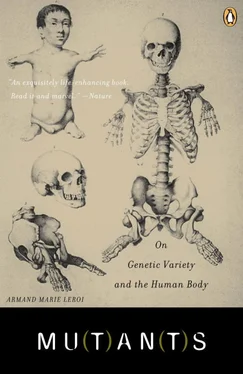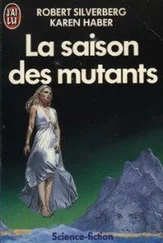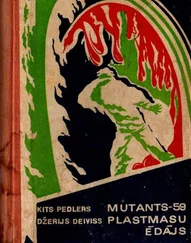
WILD TYPE MOUSE (LEFT); SONIC HEDGEHOG-DEFECTIVE MOUSE (RIGHT).
An embryo’s face is formed from five lumpy prominences that start out distinct, but later fuse with each other. Two of them become the upper jaw, two become the lower jaw, while one in front makes the nose, philtrum and forehead. These five prominences secrete sonic hedgehog protein. Sonic, in turn, controls their growth, and in doing so the geometry of the face. More exactly, it regulates its width. It sets the spaces between our ears, eyes and even our nostrils. We know this because chicken embryos whose faces are dosed with extra sonic protein develop unusually wide faces. If the dose is increased even further their faces become so wide that they start duplicating structures – and end up with two beaks side by side. Something like this also occurs naturally in humans. Several genetic disorders are marked by extremely wide-set eyes, a trait known as hypertelorism. One of these is caused by mutations in a gene that normally limits sonic’s activity. Patients with another hypertelorism syndrome even resemble the sonic-dosed chickens in having very broad noses, or else noses with two tips, or even two noses.
Disorders of this sort prompt the question of just how wide a face can be. If, as a face becomes wider and wider, parts start duplicating, might one not ultimately end up with a completely duplicated face – and so two individuals? It is not an academic question. One San Francisco-born pig arrived in the world with two snouts, two tongues, two oesophagi and three eyes each with an optic stalk of its own. It may have started out as two twin embryos that later conjoined in extraordinary intimacy. But given that the duplication was confined to the face and forebrain it may also have grown from a single primordial embryo, but one with a very wide head. The pig’s head is preserved in a jar at the University of California San Francisco, a suitable object for philosophical reflection. Was it one pig or two? It’s a question that would have stumped Aquinas himself. Not so the scientists who cared for the beast. They ignored the metaphysics, hedged their bets, and dubbed their friend(s) ‘Ditto’.

DUPLICATION OF FACE IN A PIG: ‘DITTO’.
Among the disorders that appear regularly in the great teratology collections – the Vrolik devotes a whole cabinet to it – is a syndrome called sirenomelia. The name is taken from siren , the creatures that tempted Ulysses, and melia , for limb, but the English name, ‘mermaid syndrome’, is no less evocative. Instead of two good legs, sirenomelic infants have only one lower appendage – a tapering tube that contains a single femur, tibia and fibula. They resemble nothing so much as the fake mermaids concocted by nineteenth-century Japanese fishermen from the desiccated remains of monkeys and fish. More than Homeric echoes link cyclopia and sirenomelia. Just as cyclopia is a disorder of the midline of the face, a failure of its two sides to be sufficiently far apart, so sirenomelia is a failure in the midline of the lower limbs. A sirenomelic infant has neither a left nor a right leg but rather two legs that are somehow fused together.

SIRENOMELIA OR MERMAID SYNDROME IN A STILLBORN FOETUS. FROM B. C. HIRST AND G. A. PIERSOL 1893 HUMAN MONSTROSITIES.
The causes of sirenomelia are still not entirely known. But recently two groups of scientists independently engineered mouse strains that were defective for a particular gene. Unexpectedly, when the mice were born they had no tails and, just as sirenomelic infants do, fused hind limbs. To all appearances they were mermaid mice.
The mermaid mice were made by deleting the CYP26A1 gene. It encodes an enzyme that regulates a substance called retinoic acid. Most of the important molecules that control the construction of the embryo – that are a part of the genetic grammar – are proteins, long chains of amino acids. Retinoic acid, however, is not. Rather it is a much smaller and simpler sort of molecule, just a hydrocarbon ring with a tail. It is also one of the more mysterious of the embryo’s molecules. Because it is not a protein it has been difficult to study. For one thing, it can’t be seen in the embryo. The special stains that can be used to visualise proteins can’t be used for hydrocarbon rings. And then, because it is not a protein there is no ‘retinoic acid gene’ – no single stretch of DNA that directly encodes the information needed to make it. Instead there are just genes which encode enzymes that manufacture retinoic acid or degrade it – a frustratingly indirect relationship between gene and substance.
Even so, there have long been hints that retinoic acid is important. Embryos manufacture their retinoic acid from vitamin A – the need of which has been clear since 1932, when a sow at a Texas agricultural college that had been fed a vitamin A-deficient diet gave birth to eleven piglets all of which lacked eyeballs. Conversely, the consequences of too much retinoic acid became apparent in the 1980s when a related molecule called isotretinoin was extensively prescribed for severe acne. The drug was taken orally, and though its teratogenic effects were by this time well known some women took it while unwittingly pregnant. In one study of thirty-six such pregnancies, twenty-three superficially normal infants were born, eight ended in miscarriages, and five infants were malformed, their defects including cleft palates, heart defects, disordered central nervous systems and missing ears.
Some scientists have tried to repeat this unplanned experiment by bathing animal embryos in retinoic acid and then looking for malformations. Often the outcome is just a miscellany of deformities, rather like those shown by isotretinoin-exposed infants. But sometimes the results can be spectacular. If a tadpole’s tail is amputated, it normally grows another one in short order. But if the tail is amputated and the stump is painted with a solution of retinoic acid, the tadpole grows a bouquet of extra legs. This experiment clearly shows that retinoic acid is powerful stuff. It also suggests that tadpoles may use retinoic acid to regulate their rears. It does not, however, prove it. One could object that retinoic acid is, in effect, an exotic sort of poison, one that interferes in a completely unnatural way with the normal course of the embryo’s progress.
Hence the importance of the mermaid mice. They give, for the first time, some real insight into what embryos use retinoic acid for. It seems it is a morphogen, one of the most important in the embryo. Indeed, one might almost call it an Über -morphogen that acts the length and breadth of the embryo. Being a hydrocarbon ring, however, it works rather differently from most other morphogens. Where protein-signalling molecules are too big to enter cells and so bind to receptors on their surfaces, retinoic acid penetrates the cell membrane and attaches to receptors within the cell that go right to the nucleus where they turn genes on and off.
Where does retinoic acid come from? And what, exactly, does it do? The CYP26A1 gene encodes an enzyme that degrades retinoic acid. Thus CYP26A1-defective mice have too much of it. Their mermaid-like limbs are caused by an anomalous surplus of retinoic acid in the embryo’s rear. The rear of an embryo is not the only place affected by high levels of retinoic acid. Sirenomelic infants and mice also usually have head defects – implying that retinoic acid is normally lacking there too. Indeed, it is currently thought that could the concentration gradient of retinoic acid across an embryo be seen, it would resemble a hill with a peak somewhere near the embryo’s future neck and slopes in all directions: sides, front and back. It would show a carefully constructed topography maintained by a balance of enzymes that make and degrade the morphogen, which in frogs with extra legs, mermaid mice, sirenomelic infants and foetuses exposed to acne-medications has been eroded away leaving only an ill-defined plateau.
Читать дальше















